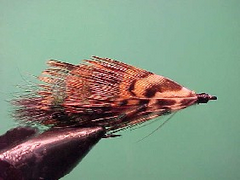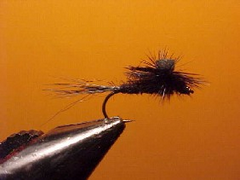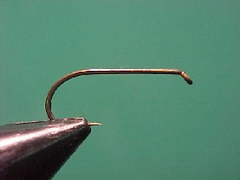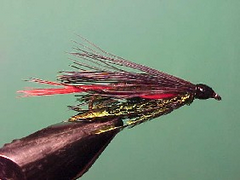Free fly tying
{{start}}
{{end}}

{{+1}}Killer type flies{{-1}}
{{start}}
The term "Killer" flies refers to a style of fly rather than just a particular pattern. The common ingredient in the style is that successive pairs of feathers are tied along the side of the flies vertically. Although there is some controversy over the actual origin of the style New Zealander Frank Lord is generally accredited with development of the style.{{end}}

{{+1}}Parachute fly- post and hackle{{-1}}
{{start}}
A lot of emerger type flies are tied with a parachute hackle rather than a traditional hackle mainly because the finished fly sits deeper in the water. The technique for tying in the parachute hackle is similar to that for tying in a traditional dry fly hackle except the hackle is wound around a post as apposed to the shank of the hook.{{end}}
{{+1}}Hook – winding thread onto the hook{{-1}}
{{start}}
It doesn't matter if a recipe says "wind thread in touching turns from the eye of the hook to the bend of the hook" or "wind just a little thread at the bend of the hook" or "build up a head of thread" etc. etc. the same following principals apply.{{end}}
{{+1}}Hooks – selecting the right hook{{-1}}
{{start}}
You could spend a lot of time to understand why hooks work for particular applications. The list below is just a small splattering of the types of hooks available but has been selected so as to help develop an understand of why different types of hooks are chosen for different purposes.{{end}}

{{+1}}Hook – description & correct placement in the vice{{-1}}
{{start}}
Correct placement of the hook in the vice definitely has an effect on the quality of the fly you tie. If the hook is placed in the vice incorrectly the hook may be weakened or it may be more difficult than it needs to be to tie the fly.{{end}}

{{+1}}Thread heads{{-1}}
{{start}}
This can be one of the easiest things to do in fly tying or one of the hardest. And the difference between being easy or hard boils down to just one thing and that's space.{{end}}
{{+1}}Half hitches & multiple hitches{{-1}}
{{start}}
Tying half hitches by hand without the use of any tools is a great skill to learn. It can be used to lock materials in as you move through the construction process of a fly or can be used to do the whip finishing of a fly either right at the eye of a fly or part way down the dressing, for example behind a bead head.{{end}}
{{+1}}Single hitches done with a biro (remove the refill first){{-1}}
{{start}}
You don't need a tool to whip finish a fly - a number of single hitches using a biro end with the refill removed are much more versatile and a single hitch can be used for locking in material at various stages of a fly's construction.{{end}}
{{+1}}Multiple hitches done with a biro (remove the refill first){{-1}}
{{start}}
You don't need a tool to whip finish a fly - Multiple hitches using a biro end with the refill removed are much more versatile.{{end}}
{{+1}}Proportions – trout flies{{-1}}
{{start}}
One of the biggest problems with tying a "good looking" and "good fishing" fly is getting the proportions correct. All to often flies are designed or tied for fisher folk not fish. When you look at a fly think about what the fish sees and what the various components of the fly are designed to do. The second problem with getting the proportions correct when tying a fly is following only part of a proven recipe without thinking through the effect of the changes you make.{{end}}













